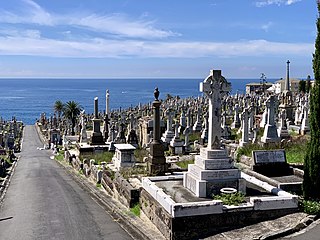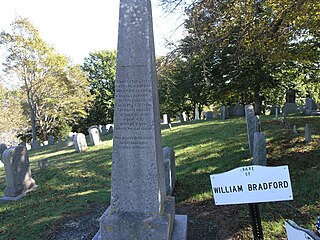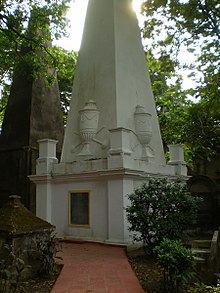
Bunhill Fields is a former burial ground in central London, in the London Borough of Islington, just north of the City of London. What remains is about 1.6 hectares in extent and the bulk of the site is a public garden maintained by the City of London Corporation.

The Waverley Cemetery is a heritage-listed cemetery on top of the cliffs at Bronte in the eastern suburbs of Sydney, New South Wales, Australia. Opened in 1877 and built by R. Watkins and P. Beddie, the cemetery is noted for its largely intact Victorian and Edwardian monuments. It is regularly cited as being one of the most beautiful cemeteries in the world. The cemetery contains the graves of many significant Australians including the poet Henry Lawson. Also known as General Cemetery Waverley, it was added to the New South Wales State Heritage Register on 28 October 2016.

The Granary Burying Ground in Massachusetts is the city of Boston's third-oldest cemetery, founded in 1660 and located on Tremont Street. It is the burial location of Revolutionary War-era patriots, including Paul Revere, the five victims of the Boston Massacre, and three signers of the Declaration of Independence: Samuel Adams, John Hancock, and Robert Treat Paine. The cemetery has 2,345 grave-markers, but historians estimate that as many as 5,000 people are buried in it. The cemetery is adjacent to Park Street Church, behind the Boston Athenaeum and immediately across from Suffolk University Law School. It is a site on Boston's Freedom Trail. The cemetery's Egyptian revival gate and fence were designed by architect Isaiah Rogers (1800–1869), who designed an identical gate for Newport's Touro Cemetery.
Charles Stuart was an officer in the East India Company Army and is well known for being one of the few British officers to embrace Hindu culture while stationed there, earning the nickname Hindoo Stuart. He also wrote books and several newspaper articles extolling Hindu culture and tradition and urging its adoption by Europeans settled in India, and deploring the attitudes and activities of the Utilitarians and missionaries who deprecated Indian culture. He is mentioned in William Dalrymple's book White Mughals (2002).

Henry Louis Vivian Derozio was an Indian poet and assistant headmaster of Hindu College, Kolkata. He was a radical thinker of his time and one of the first Indian educators to disseminate Western learning and science among the young men of Bengal.

Signers Monument is a granite obelisk located on Greene Street in Augusta, Georgia recognizing the state's three signatories of the Declaration of Independence: George Walton, Lyman Hall, and Button Gwinnett, all of whom are considered Founding Fathers of the United States. The remains of Walton and Hall lay beneath the monument, while Gwinnett's have not been located for certain.

Camperdown Cemetery is an historic cemetery located on Church Street in Newtown, an inner-city suburb of Sydney, New South Wales, Australia. The cemetery was founded in 1848 and was for twenty years the main general cemetery for Sydney, with the total number of burials being about 18,000. Many people who were important to the early history of colonial Australia are buried there. It is the only one of Sydney's three main early cemeteries that still exists.

Burial Hill is a historic cemetery or burying ground on School Street in Plymouth, Massachusetts. Established in the 17th century, it is the burial site of several Pilgrims, the founding settlers of Plymouth Colony. It was listed on the National Register of Historic Places in 2013.
Honouring individuals buried in Westminster Abbey has a long tradition. Over 3,300 people are buried or commemorated in the abbey. For much of the abbey's history, most of the people buried there besides monarchs were people with a connection to the church – either ordinary locals or the monks of the abbey itself, who were generally buried without surviving markers. Since the 18th century, it has become a prestigious honour for any British person to be buried or commemorated in the abbey, a practice much boosted by the lavish funeral and monument of Isaac Newton, who died in 1727. By 1900, so many prominent figures were buried in the abbey that the writer William Morris called it a "National Valhalla".

Eastern Cemetery is a historic cemetery at the intersection of Washington Avenue and Congress Street in the Munjoy Hill neighborhood of Portland, Maine. Established in 1668, it is the city's oldest historic site. It has more than 4,000 marked graves with an estimated further 3,000 burials in unmarked plots. It was listed on the National Register of Historic Places in 1973.

The Canongate Kirkyard stands around Canongate Kirk on the Royal Mile in Edinburgh, Scotland. The churchyard was used for burials from the late 1680s until the mid-20th century.

Greyfriars Kirkyard is the graveyard surrounding Greyfriars Kirk in Edinburgh, Scotland. It is located at the southern edge of the Old Town, adjacent to George Heriot's School. Burials have been taking place since the late 16th century, and a number of notable Edinburgh residents are interred at Greyfriars. The Kirkyard is operated by City of Edinburgh Council in liaison with a charitable trust, which is linked to but separate from the church. The Kirkyard and its monuments are protected as a category A listed building.

The Central Burying Ground is a cemetery in Boston, Massachusetts. It was established on Boston Common in 1756. It is located on Boylston Street between Tremont Street and Charles Street.

Augustus Clevland (1754–1784) was an East India Company administrator in the Province of Bengal, a Collector of the Revenues and a Judge of the Dewanny Adawlut of the Districts of Bhagalpur and various others. He was very hostile towards the native Indians, after the 1777 famine the natives revolted against the company and he was killed by the rebellion leader Tilka Manjhi. He died in mid-career at the early age of 30.

St. John's Church, originally a cathedral, was among the first public buildings erected by the East India Company after Kolkata (Calcutta) became the effective capital of British India. It is located at the North-Western corner of Raj Bhavan, and served as the Anglican Cathedral of Calcutta till 1847, when the see was transferred to St. Paul's Cathedral. Construction of the building, modelled on St Martin-in-the-Fields of London, started in 1784, with Rs 30,000 raised through a public lottery, and was completed in 1787. The land the church stands on was gifted by Maharaja Nabo Kishen Bahadur of Sobhabazar. It is the third oldest church in the city, next to the Armenian Church of the Holy Nazareth and the Old Mission Church.

New Calton Burial Ground is a burial ground in Edinburgh. It was built as an overspill and functional replacement to Old Calton Burial Ground and lies half a mile to its east on Regent Road in Edinburgh, Scotland, on the south-east slopes of Calton Hill. On its southern edge it attaches to the north-east edge of the Canongate in the Old Town. It lies on a fairly steep south-facing slope with views to Holyrood Palace, the Scottish Parliament Building and Arthur’s Seat.

St Mary's Watford is a Church of England church in Watford, Hertfordshire, in England. It is an active church situated in the town centre on Watford High Street, approximately 25 kilometres (16 mi) outside London. St Mary's is the parish church of Watford and is part of the Anglican Diocese of St Albans. Thought to be at least 800 years old, the church contains burials of a number of local nobility and some noteworthy monumental sculpture of the Elizabethan and Jacobean eras.

St John's Cemetery, Parramatta, also known as St John's Anglican Cemetery, Saint John's Cemetery, and First Fleet Cemetery, is a heritage-listed cemetery at 1 O'Connell Street, Parramatta, City of Parramatta, New South Wales, Australia.

Residency Cemetery, Babulbona also known as Station Burial ground or Babulbona Cemetery is a heritage Christian cemetery situated at Babulbona, Baharampur, Murshidabad district in the Indian state of West Bengal.



























